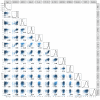Combination of inflammatory and vascular markers in the febrile phase of dengue is associated with more severe outcomes
- PMID: 34154705
- PMCID: PMC8331184
- DOI: 10.7554/eLife.67460
Combination of inflammatory and vascular markers in the febrile phase of dengue is associated with more severe outcomes
Abstract
Background: Early identification of severe dengue patients is important regarding patient management and resource allocation. We investigated the association of 10 biomarkers (VCAM-1, SDC-1, Ang-2, IL-8, IP-10, IL-1RA, sCD163, sTREM-1, ferritin, CRP) with the development of severe/moderate dengue (S/MD).
Methods: We performed a nested case-control study from a multi-country study. A total of 281 S/MD and 556 uncomplicated dengue cases were included.
Results: On days 1-3 from symptom onset, higher levels of any biomarker increased the risk of developing S/MD. When assessing together, SDC-1 and IL-1RA were stable, while IP-10 changed the association from positive to negative; others showed weaker associations. The best combinations associated with S/MD comprised IL-1RA, Ang-2, IL-8, ferritin, IP-10, and SDC-1 for children, and SDC-1, IL-8, ferritin, sTREM-1, IL-1RA, IP-10, and sCD163 for adults.
Conclusions: Our findings assist the development of biomarker panels for clinical use and could improve triage and risk prediction in dengue patients.
Funding: This study was supported by the EU's Seventh Framework Programme (FP7-281803 IDAMS), the WHO, and the Bill and Melinda Gates Foundation.
Keywords: biomarkers; dengue; infectious disease; medicine; microbiology; prognostic; virus.
© 2021, Vuong et al.
Conflict of interest statement
NV, PL, HD, NN, DT, KD, NC, NC, EP, CS, KR, DB, NA, CH, PO No competing interests declared, DM reports receiving personal fees from the Wellcome Trust (grant number 215010/Z/18/Z), during the conduct of the study. LL reports receiving personal fees from ROCHE Advisory Board on Severe Dengue. TJ reports receiving personal fees as members of the ROCHE Advisory Board on Severe Dengue, outside the submitted work. BW reports personal fees as a member of the Data Monitoring and Adjudication Committees for the Takeda dengue vaccine trials and as a member of the ROCHE Advisory Board on Severe Dengue, outside the submitted work. RG reports receiving personal fees from the Wellcome Trust (grant number 106680/Z/14/Z), during the conduct of the study. SY reports receiving personal fees as a member of the ROCHE Advisory Board on Severe Dengue, for work on Janssen Pharmaceuticals Advisory Board for Dengue Antiviral Development, and from the Wellcome Trust (grant number 106680/Z/14/Z).
Figures











References
-
- Bartoń K. MuMIn: Multi-Model Inference. 1.43.17R Package Version. 2020 https://CRAN.R-project.org/package=MuMIn
-
- Brasier AR, Ju H, Garcia J, Spratt HM, Victor SS, Forshey BM, Halsey ES, Comach G, Sierra G, Blair PJ, Rocha C, Morrison AC, Scott TW, Bazan I, Kochel TJ, Venezuelan Dengue Fever Working Group A three-component biomarker panel for prediction of dengue hemorrhagic fever. The American Journal of Tropical Medicine and Hygiene. 2012;86:341–348. doi: 10.4269/ajtmh.2012.11-0469. - DOI - PMC - PubMed
-
- Conroy AL, Gélvez M, Hawkes M, Rajwans N, Tran V, Liles WC, Villar-Centeno LA, Kain KC. Host biomarkers are associated with progression to dengue haemorrhagic fever: a nested case-control study. International Journal of Infectious Diseases. 2015;40:45–53. doi: 10.1016/j.ijid.2015.07.027. - DOI - PubMed
Publication types
MeSH terms
Substances
Grants and funding
LinkOut - more resources
Full Text Sources
Other Literature Sources
Medical
Research Materials
Miscellaneous

